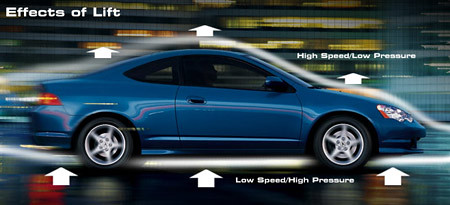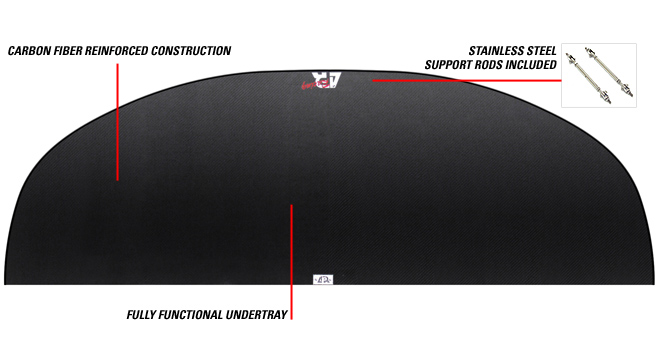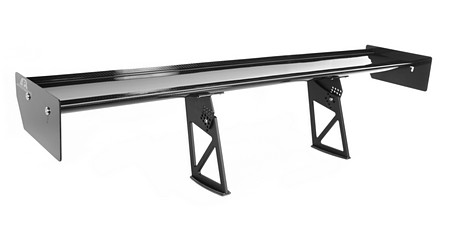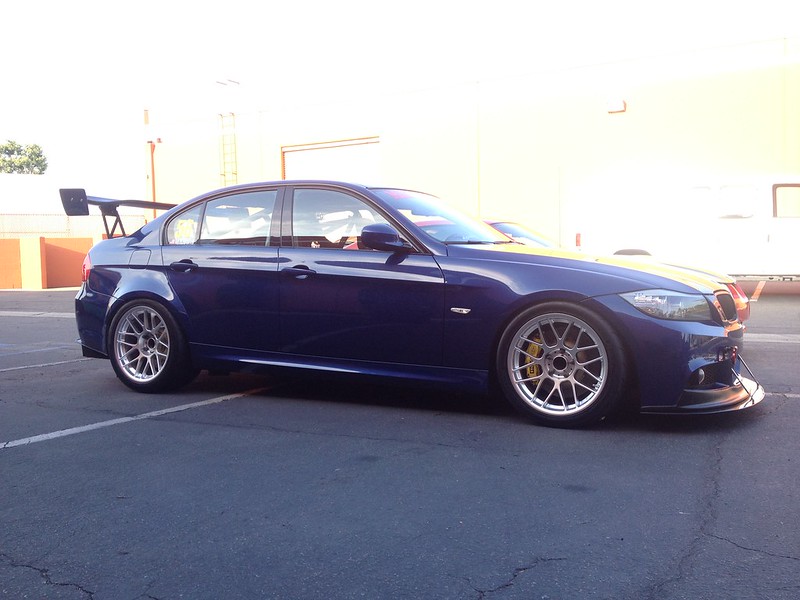

|
|
 |
 |
 |
|
 |
BMW Garage | BMW Meets | Register | Today's Posts | Search |
 |

|
BMW 3-Series (E90 E92) Forum
>
HP Autosport | APR Performance
|
 |
| 11-18-2013, 06:07 PM | #1 |
|
Supreme Allied Commander
 
4241
Rep 56,310
Posts
Drives: F80 M3
Join Date: Mar 2007
Location: Santa Barbara, AP, Brembo, GIAC, Koni, Ohlins, Performance Friction, www.hpautosport.com
|
Why Cars Need Downforce
Weíve all seen race cars and how they utilize aero kits, canards, splitters, diffusers and wings to help improve their performance. But why go through all the trouble to seek that competitive edge? What are the dynamics going on that makes race teams spend so much time and resources on improving their cars aerodynamics? To understand the dynamics involved with such components, it is important to know some principals of aerodynamics. The Effects of Lift and Downforce Depending on its shape, an object traveling through air will always be lifting upward or downward. If itís lifting upward, the effect is simply known as lift. If itís downward, the effect is known as downforce. Most cars lift as they travel through air because of their shape. The reason why is because of an aerodynamic principal discovered by Swiss scientist Daniel Bernoulli. The Bernoulli Effect simply states the higher the speed of air molecules traveling around an object, the lower the air pressure becomes around that object. In contrast, the lower the speed of air molecules traveling around an object, the higher the air pressure becomes. Diagram showing how air flow can effect lift on a carÖ  As a car travels forward it is bombarded with air molecules. Air needs places to escape once they have approached the front of the car. They can either flow over, around and under the car. You would think that since there is more space above the car, air pressure should be higher on the top surface, but that is not the case. A car has lower pressure on the top and higher pressure below because of the Bernoulli Effect. Since the speed of air molecules travels faster over the top of the car, the density of air molecules becomes lower making low pressure above the car. Alternately, because air travels faster over the top and slower below the car, more air molecules are squeezed underneath a car making the pressure higher. These forces are what cause cars to lift up as they gain speed. Problems with Lift and the Importance of Downforce on the Race Track If a race car is constantly lifting, it does not have the traction and control it needs to go fast and those are some of the key components to faster lap times. Cars need controllability and traction to retain higher speeds through turns. If a car cannot retain higher speeds through turns, then time ultimately is lost. One example of how much lift can be generated on a car is the lift on a stock 2000 Volkswagen Beetle. A stock Beetle can produce 742 lbs of lift at 124 mph! Since a Beetle weights roughly 2700 lbs, nearly 25% of a Beetleís weight is actually lifting at that speed. Imagine building a high powered Beetle race car. You think with 25% less ground traction at 124 mph to the ground will be beneficial to a faster time on a straight away? To combat lifting, aerodynamic components are utilized to produce downforce. Components such as aerodynamic kits, canards, splitters, diffusers and wings are performance additions race car teams have utilized to create downforce for their race cars. APR has developed their product line to not only give street cars a race car appearance, but to also give street cars a functional performance upgrade that can help on the race track. Thatís why many road racers, drifters and drag racers have trusted APR products on their cars when time to battle on the track has come. :::The Product Lineup::: 1) Carbon Fiber Front Splitter - $395.00 A Front Wind Splitter is a protruding flat surface in the front of a car that is designed to decrease front end lift and exert downforce. By creating a high pressure area on top of the wind splitter, high pressure air flow is restricted to flow underneath a car. With low pressure below the car, the effect of lift is reduced and a driver can gain from the extra traction and control. The APR Performance Front Wind Splitter (hereinafter referred to as "Splitter") is an aerodynamic tuning component that plays an important role in helping a vehicle achieve aerodynamic balance. Just as there are significant forces acting upon the rear-end of a rear wing-equipped vehicle, there are also significant forces acting upon the front-end of a Splitter-equipped vehicle. 2) GTC-300 Wing (Carbon) - $1575.00 All GTC Series wings feature an aerodynamic 3D designed airfoil shape to obtain the optimal balance of downforce. This design allows for a reduction in drag, yet maintains an ideal level of downforce. Computational Fluid Dynamics (CFD) Analyses were performed on these wings to support validation of their aerodynamic design. Each GTC Series airfoil is composed of lightweight and durable carbon fiber reinforced polymer (CFRP) composite materials. These airfoils contain pre-pregnated woven carbon fiber sheets for superior strength and low weight. All CFRP airfoils are made using pre-pregnated composite manufacturing processes (i.e. high-temperature autoclave and vacuum bagging) in high-quality aluminum billet molds. Each GTC Series airfoil is composed of lightweight and durable carbon fiber composite. Supporting the carbon fiber airfoils are 10mm "aircraft grade" 6061 billet aluminum pedestals that come in a flat black powder coat finish. 3) GT-200 Wing (Carbon) - $1645.00 to $1795.00 All GT Series wings feature an all-new, low-drag, aerodynamic 2D designed airfoil shape. The "2D" design allows the wing to maintain a consistent level of downforce across its entire span. Computational Fluid Dynamics (CFD) Analyses were performed on these wings to support validation of their aerodynamic design. Each GT Series airfoil is composed of lightweight and durable carbon fiber reinforced polymer (CFRP) composite materials. These airfoils contain pre-pregnated woven carbon fiber sheets for superior strength and low weight. All CFRP airfoils are made using pre-pregnated composite manufacturing processes (i.e. high-temperature autoclave and vacuum bagging) in high-quality aluminum billet molds. Each GT Series airfoil is composed of lightweight and durable carbon fiber composite. Supporting the carbon fiber airfoils are 10mm "aircraft grade" 6061 billet aluminum pedestals that come in a flat black powder coat finish. GTC-300 (67" Carbon) + APR Front Lip: Hp Autosport is proud to 're'-introduce the products of APR to the Bimmerpost community. APR has been known throughout the motorsports world to manufacture the best aerodynamics parts for all vehicle applications. Their products have been used on such vehicles ranging from multiple championship winning Pike's Peak Rally cars to Time Attack cars found across Southern California. My car (blue car shown above) shaved a over 5 seconds off my Willow Spring (Big Willow) track times with the addition of the APR front spoiler and rear wing. These are MUST haves for anybody interested in shaving lap times and having a more compliant and responsive automobile.  Not only are APR parts used for racing applications, but can be used as a nice cosmetic touch. The Carbon Splitter will fit under any lip application to give a sleek & multidimensional touch to any BMW front end. Please visit HP Autowerks Aerodynamics for pricing and further information. Last edited by HP Autosport; 01-05-2017 at 12:08 PM.. |
|
|
 |
| Bookmarks |
|
|